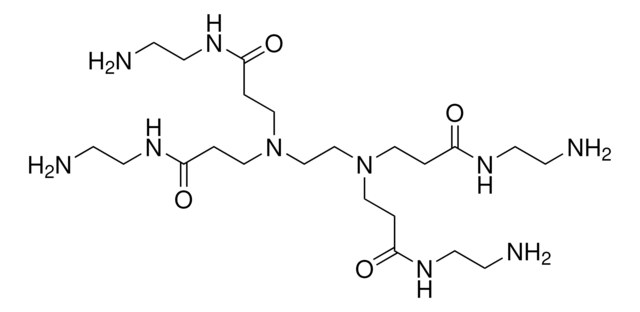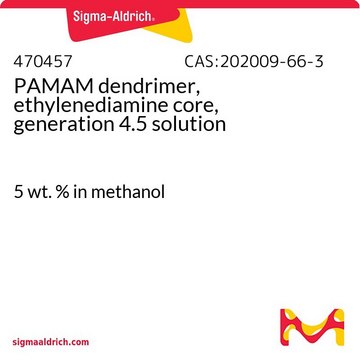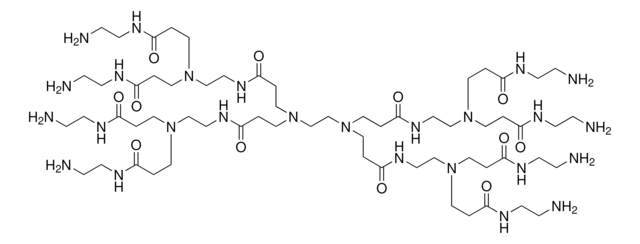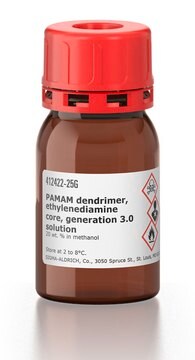536709
PAMAM dendrimer, ethylenediamine core, generation 5.0 solution
5 wt. % in methanol
Synonim(y):
Poly(amidoamine)
About This Item
Polecane produkty
opis
amino surface groups
Poziom jakości
Postać
liquid
masa cząsteczkowa
generation 5.0
Właściwości
core type ethylenediamine core (2-carbon core)
stężenie
5 wt. % in methanol
liczba grup powierzchniowych
128
gęstość
0.797 g/mL at 25 °C
temp. przechowywania
2-8°C
Opis ogólny
Zastosowanie
- Synthesis of beta-Cyclodextrin-Decorated Dendritic Compounds Based on EDTA Core: This study presents an alternative to the ethylenediamine core in PAMAM dendrimers, using an EDTA core instead, providing insights into modifications that affect the dendrimers properties (Gonzalez Mendez et al., 2022).
- New Advances in General Biomedical Applications of PAMAM Dendrimers: Discusses the composition variations of PAMAM dendrimer cores, including ethylenediamine, and their implications on biomedical applications (Araujo et al., 2018).
- Poly (amidoamine) Dendrimers: Covalent and Supramolecular Synthesis: This paper reviews various synthetic strategies for PAMAM dendrimers, emphasizing the role of the ethylenediamine core in their structural formation (Lyu et al., 2019).
- Modified Carboxyl-Terminated PAMAM Dendrimers as a Cytocompatible Nano Based Drug Delivery System: Examines the biocompatibility and drug delivery efficiency of modified PAMAM dendrimers, highlighting the cores critical role (Vu et al., 2019).
- Use of Polyaminoamide Dendrimers Starting from Different Core-Initial Molecules for Inhibition of Silica Scale: This study explores the use of ethylenediamine-core PAMAM dendrimers in industrial applications, particularly for silica scale inhibition (Sun et al., 2021).
Postać fizyczna
Informacje prawne
Hasło ostrzegawcze
Danger
Zwroty wskazujące rodzaj zagrożenia
Zwroty wskazujące środki ostrożności
Klasyfikacja zagrożeń
Acute Tox. 3 Dermal - Acute Tox. 3 Inhalation - Acute Tox. 3 Oral - Flam. Liq. 2 - STOT SE 1
Organy docelowe
Eyes
Kod klasy składowania
3 - Flammable liquids
Klasa zagrożenia wodnego (WGK)
WGK 3
Temperatura zapłonu (°F)
49.5 °F - closed cup - Methanol
Temperatura zapłonu (°C)
9.7 °C - closed cup - Methanol
Wybierz jedną z najnowszych wersji:
Masz już ten produkt?
Dokumenty związane z niedawno zakupionymi produktami zostały zamieszczone w Bibliotece dokumentów.
Klienci oglądali również te produkty
Produkty
Environmental concerns are driving the replacement of volatile organic solvents by water and aqueous mixtures. This change often creates challenges because many organic molecules show low water solubility.
Nasz zespół naukowców ma doświadczenie we wszystkich obszarach badań, w tym w naukach przyrodniczych, materiałoznawstwie, syntezie chemicznej, chromatografii, analityce i wielu innych dziedzinach.
Skontaktuj się z zespołem ds. pomocy technicznej















